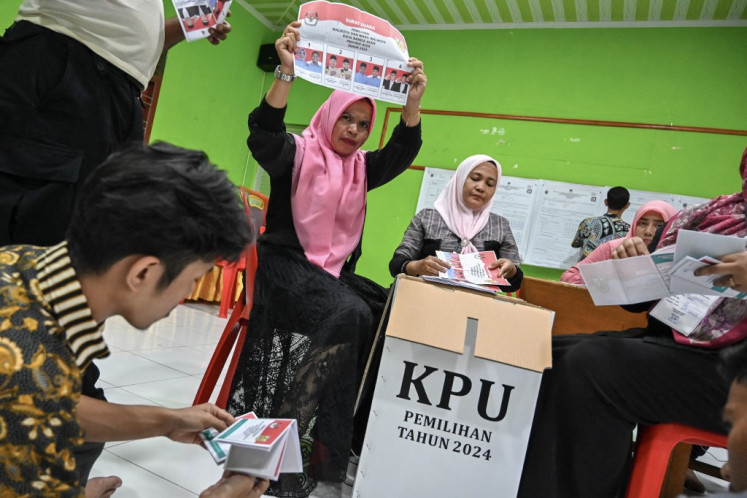Popular Reads
Top Results
Can't find what you're looking for?
View all search resultsPopular Reads
Top Results
Can't find what you're looking for?
View all search resultsGusti Moeng: The worries of a rebel princess
JP/Ganug Nugroho AdiThe princess was leaning against a pillar in the hall in front of Panti Rukmi, an old and pallid structure in the Keputren complex, a building for the king’s consorts and daughters at the palace of the Surakarta Sultanate
Change text size
Gift Premium Articles
to Anyone
J
span class="caption" style="width: 398px;">JP/Ganug Nugroho AdiThe princess was leaning against a pillar in the hall in front of Panti Rukmi, an old and pallid structure in the Keputren complex, a building for the king’s consorts and daughters at the palace of the Surakarta Sultanate.
I feel like crying every time I see the buildings here. Nearly all of them are grubby, damaged and uncared for. Weeds and bushes are everywhere. It’s ironic as the ‘Spirit of Java’ is Solo’s slogan,” she said.
She is Gusti Kanjeng Ratu Wandansari, usually called Gusti Moeng, one of the daughters of Surakarta Sultan Sampeyandalem Ingkang Sinuhun Kanjeng Susuhunan Paku Buwono XII (1944-2004). Moeng is derived from her childhood name, Gusti Raden Ayu Koes Moertiyah.
“The palace cannot afford to renovate the buildings. Some of them are indeed still well preserved, but many more are only awaiting collapse,” she said.
The inside of the palace is in fact not as grand as its exterior. Many structures are rotting, with peeling, cracked walls so that mold and grass are almost covering them. In another part of the palace several buildings are vacant, with no windows and doors still intact. Tall weeds grow in the yard.
“It’s the present situation of the palace. I’m concerned but I will keep striving to make this court again a worthy heritage place for sightseeing,” said the Surakarta palace’s internal affairs head.
Born in Solo on Nov. 1, 1960, Gusti Moeng grew up with a strict palace upbringing filled with tradition. But, her position as a princess has not led to a life of indulgence and luxury.
“Sinuhun [Paku Buwono XII] was very stern in educating his children. We were obliged to learn the various skills connected with the court, including batik making, Javanese poetry singing and classical dancing,” she recalled.
Living in that kind of royal environment more or less made her feel confined. Unsurprisingly, she frequently rebelled against court tradition. As a child, for instance, she preferred going to the martial arts training for men rather than dancing and singing.
Gusti Moeng also refused to go to the special school for royals and instead chose public school. Owing to her defiant attitude, she has been nicknamed putri mbalela or rebel princess.
“In public school, our classmates were of diverse origins so we could get familiar with different backgrounds,” said the wife of Kanjeng Pangeran Haryo Edy Wirabumi.
With her broad associations outside the palace, Gusti Moeng became interested in social activities and joined the board of the students’ organizations when she was in junior and senior high school. At Sebelas Maret State University (UNS) in Solo, she was active in the student senate.
“It was during college that I gradually learned about politics. Sinuhun taught me politics by having frequent discussions with me about palace affairs,” said Gusti Moeng, also a member of the House of Representatives for the 2009-2014 term.
Despite her rebellious inclinations, Gusti Moeng has a deep love for the palace so that she is adamantly endeavoring to preserve the court and all its heirlooms and traditions.
“The palace is not mere heritage. It involves the appreciation of ancestral history and struggle. It is also a matter of how to preserve this heritage as a center of Javanese culture,” she said.
In spite of her worries, the fair-skinned lady has always been enthusiastic about the maintenance of the palace. Her anxieties have not only arisen from the many court buildings still in bad repair, but also
from the large number of heirlooms to be rescued.
According to Gusti Moeng, the palace keeps at least 500 invaluable relics and articles such as bronze and stone statues, equipment for court ceremonies, royal attire and jewelry, gamelan instruments, masks, photos, paintings, sedan chairs and various weapons from krises and spears to swords. Some of these heirlooms are displayed at the museum and others at the library.
“The palace also stores around 6,000 books including babad [chronicles], poetry collections and recipes. What’s to be done with the whole treasure? The government should play an active role. Will the younger generation never be acquainted with all the assets because the palace as cultural center is gone?” she asked.
She described the state of the palace today as paradoxical. On the one hand, the palace as a Javanese cultural heritage site must not disappear, while on the other hand efforts to preserve it are halfheartedly carried out by the government.
“Frankly, the palace can’t afford to undertake the effort alone. It doesn’t have sufficient funds,” she said.
But more than just lamenting the court’s poor physical condition, she also expressed her apprehension about the nation’s approach to its cultural heritage.
“I witness members of our generation drifting along with modern culture. Their feet are practically not rooted in their ancestral culture. Someday, the palace as [Javanese] cultural center will gradually be abandoned,” she said.
Not all citizens are like that, of course, because as Gusti Moeng put it, amid the intense pressures from global influences, a small part of the younger generation remains interested in learning elements of palace culture. For example, every year the number of youth learning to become pambiworo (a master of ceremonies) at the Surakarta Palace increases.
“In the last five years, the pambiworo studio has passed 100 to 200 students annually. I thank God as most of them are younger citizens,” she noted.
But Gusti Moeng can understand the inevitability of globalization, for otherwise the nation would be lagging far behind. Even the palace as a cultural symbol has begun to open up to globalization and modernization. Many women of the nobility have entered politics although it used to be a palace taboo.
“What must not happen is that we just let the stream of globalization overwhelm the culture of a nation, rendering it shapeless,” Gusti
Moeng said.
Amid her busy schedule as a legislator, this woman continues her pursuit to restore the grandeur of the Surakarta Palace that is now beginning to fade by, among other things, demanding the fulfillment of the central government’s pledge to revitalize the premises.
“As a member of the royal family, I bear the great responsibility of maintaining the existence of this palace,” she said.










